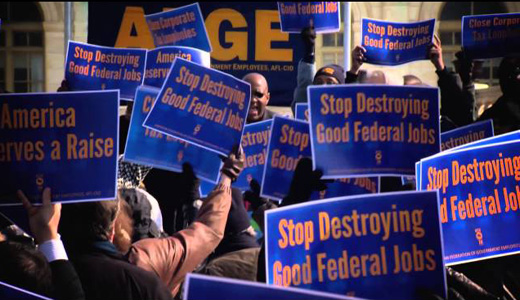
WASHINGTON (PAI) – After a three-year pay freeze, two following years of “itsy-bitsy” raises and $182 billion in worker givebacks – featuring higher worker pension contributions without accompanying payout promises – American Federation of Government Employees members are demanding a 5.3 percent raise for the nation’s federal employees.
But even though Reps. Gerry Connolly, D-Va., and Richard Nolan, DFL-Minn., are poised to introduce the proposal on Capitol Hill, the workers probably won’t get it.
That’s because President Obama, in his budget blueprint for the fiscal year that begins Oct. 1, proposes a 1.6 percent hike for federal workers. And Congress’ ruling Republicans are so hostile to both Obama and federal workers that they aren’t even going to hold hearings on Obama’s proposed budget at all.
“We may or may not get the 5.3, but we are putting on the record that we need the 5.3” to start to make up for years of no and low pay, AFGE President J. David Cox told reporters.
At a Feb. 9 rally in freezing rain, Cox called past pay hikes “an itsy-bitsy teeny-weeny raise.” The workers’ demand – “What do we want? 5.3! When do we want it? Now!” they chanted — drew support from Nolan, Connolly, House Minority Leader Nancy Pelosi, D-Calif., AFL-CIO President Richard Trumka and other speakers.
“You make America strong,” the hatless Trumka told the crowd. “Patriotism is more than waving the flag back and forth. It calls on the American people to treat public employees with dignity and respect. We say ‘Put your money where your mouth is.'”
The 5.3 percent hike is the top legislative goal of AFGE and the centerpiece of lobbying by its 900 Legislative Conference delegates who came from around the country to D.C. on Feb. 7-9. Some other key proposals by the 302,640-member union include:
- Giving white-collar and blue-collar federal workers in the same metro area the same “locality pay” increases. In high-priced areas, such as New York and San Francisco, both groups get extra pay to cover higher costs of living.
White-collar workers’ locality pay is based on current metro area boundaries. Blue-collar workers’ “localities” are different, and, in many cases, smaller. So fewer of each locality pay area’s blue-collar workers, proportionally, get the boost – and they’re already paid less. The most outrageous case is at the Tobyhanna Army Depot in Scranton, Pa. Its white-collar workers are on the New York City locality scale; its blue-collar workers aren’t.
- Repeal the higher pension contributions that congressional Republicans imposed on federal workers hired since 2013. Workers hired before then pay 0.8 percent of their pay towards their pensions. Those hired in 2013 pay 3.1 percent and those hired since pay 4.4 percent. But none of the workers will get increased pension benefits as a result. The GOP used $182 billion the pension payments raised to cut federal spending.
- Prevent the government, particularly the Defense Department, from imposing yet another pay-for-performance plan which would allow total management favoritism and take away workers’ rights to appeal unjust demotions and firings. DOD tried that under the GOP Bush administration, but AFGE and other unions beat them in court and in Congress. DOD then sat down with the unions to work out a new alternative pay plan and is ready to roll it out in April, Cox said. But now some DOD officials want to resurrect a variation on the old plan.
- Put the nation’s 45,000 federally hired airport screeners, unionized with AFGE, under regular federal civil service laws, not under a separate law that applies to military members. Private firms at several airports, such as Kansas City, hire other non-federal screeners.
As a result, the federal screeners, formally called Transportation Security Officers, “don’t have a grievance procedure,” Cox says. “They have an in-house dispute resolution system which the Transportation Security Administration (TSA) won’t even
And the screeners’ pay scale is lower than that of comparable workers. Screeners are also under a pay-for-performance system that denied raises to one-fourth of them last year.
“They make about $30,000-$35,000 a year each, and the agency wants more of them to work part-time” without benefits, Cox adds. “It won’t let them trade shifts” to take care of family emergencies.
- Opposing a scheme by House Budget Committee Chairman Tom Price, R-Ga., to turn the federal and D.C. governments into complete “right to work” areas, ban payroll deductions for dues and politics, ban card-check recognition of unions, and force unions to win representation elections through absolute majorities of all voters in workplaces, not just of those voting.
Legislative conference delegates got support from Reps. Eleanor Holmes Norton, D-D.C., Mark Takano, D-Calif., and Elijah Cummings, D-Md. Norton threw another issue on the table: A Republican plan to make the Federal Aviation Administration’s 14,000 air traffic controllers independent of federal funds and control, and funded by airline passenger fees, instead. “It puts the airlines in charge of our airspace. What a reckless idea,” Norton said.
Photo: AFGE.org










